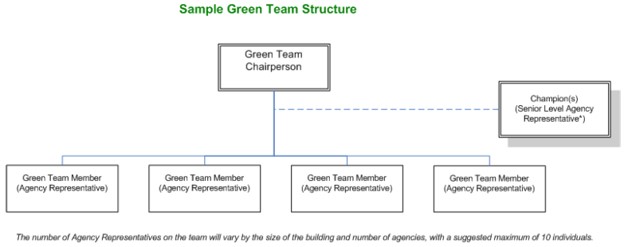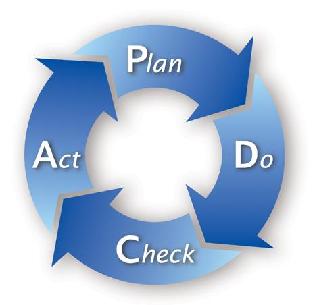Green Teams
Referred to as Green Teams, Green Project Teams, or Eco-Teams, these groups consist of occupants/tenants and building staff who voluntarily educate fellow occupants and empower their organization to adopt sustainable practices. Identifying and implementing building-specific initiatives through occupant-run programs and regularly occurring calendar events, these teams seek to create a more environmentally friendly workplace.
By promoting sustainable practices in the workplace, Green Team projects have several benefits:
- Increased occupant engagement
- Enhanced occupant and/or tenant satisfaction
- Increased cost savings
- Improved regulatory compliance and environmental performance
- Improved community impact
Use our strategies below to establish your Green Team.
Getting Started
Key Steps:1
Combined with grassroots efforts, senior-management endorsements will help Green Teams succeed. Green Teams should be treated like any other business initiative, complete with a senior level manager. See Helpful Tips: For leaders for more information.
Resources: See Sample Green Team Structure for more details on leadership structure.
The first step in kickstarting the Team is recruitment. Email staff with interest surveys (see page 13 of the Columbus, Ohio How-To Guide: Forming a Green Team at Work for sample). Make announcements at all-staff meetings or create a sign-up sheet in the break room to get on people’s radars. Include the first meeting agenda and topics' details in recruitment material. Craft Green Team outreach to the culture of the building community and tailor efforts accordingly. See the Columbus, Ohio How-To Guide: Forming a Green Team at Work
for sample). Make announcements at all-staff meetings or create a sign-up sheet in the break room to get on people’s radars. Include the first meeting agenda and topics' details in recruitment material. Craft Green Team outreach to the culture of the building community and tailor efforts accordingly. See the Columbus, Ohio How-To Guide: Forming a Green Team at Work document for more recruitment details. To maintain an active Green Team, different building offices/agencies should be represented with a cross-section of roles. Team members should include senior manager representatives but should not be limited to them. Potential offices/agencies include, but are not limited to:
document for more recruitment details. To maintain an active Green Team, different building offices/agencies should be represented with a cross-section of roles. Team members should include senior manager representatives but should not be limited to them. Potential offices/agencies include, but are not limited to:
- Building management
- Human resources
- Finance
- Marketing
- Production
- Custodial leads
- Those with unique backgrounds/perspectives
Tenants who engage in Green Teams should post a small sign in the entryway stating that they are members of the building-wide Team. This conveys support across the building and from senior leadership.
Note: GSA prefers that agencies take the lead of Green Teams within GSA owned and leased facilities. This allows property management personnel to serve as team members and resources for holding building-wide events, such as Earth Day.
Resources: Visit the Structure and Team Roles for detailed descriptions of member roles. Use the Columbus, Ohio Green Team Member Pledge & Green Team Member Supervisor Commitment forms (page 12) for supervisor-member agreement documentation. Refer to the Green Team Jackson Federal Building Charter Template
for supervisor-member agreement documentation. Refer to the Green Team Jackson Federal Building Charter Template (GSA employees only) for more information on the Team’s mission, membership, and norms.
(GSA employees only) for more information on the Team’s mission, membership, and norms.
GSA’s Property Management Office can provide details regarding energy and water use, recycling, and resources for assessing GHGs for GSA owned or leased properties. The results of the assessment should inform the Team’s priorities. If not, the following questions should be discussed:
can provide details regarding energy and water use, recycling, and resources for assessing GHGs for GSA owned or leased properties. The results of the assessment should inform the Team’s priorities. If not, the following questions should be discussed:
- What can be accomplished easily as a quick success to build support?
- What would provide the most visibility for building occupants to build commitment?
- Where are we at the most risk within the building safety, health, regulatory compliance or financially?
- Where could we achieve the most impact on reducing our negative environmental footprint?
Hold productive and engaging meetings with an appropriate frequency (e.g., twice a month in the beginning to every month thereafter). Without setting clear goals, timelines, roles, and expectations or recognizing the progress made, the Team can lose commitment and momentum.
Track Green Team performance by comparing actual measurements to targets as well as celebrating behavioral changes and progress. When assessing progress (either on a project or event basis), use the Plan, Do, Check, Act Model and ask the following questions:
- Were the goals achieved?
- What worked?
- What could be done differently?
Report achievements, best practices, and progress. Use regularly occurring events, such as Earth Day (April 22), Energy Awareness Month in October, and America Recycles Day (November 15), to share this information. Communicate through existing channels, such as newsletters, signage, websites, and lobby or building displays, to promote involvement. Recognize individuals who made new commitments to sustainability by changing/altering different practices.
With any changes, there can be resistance and uncertainties. The key to combating challenges is to accept incremental progress, as long as it is progress. Using planning and prioritizing actions at the start, Green Teams can track their progress.
Structure and Team Roles
Below is a sample structure of a Green Team provided by GSA (note: “Agency Representative” can be replaced with Office Departments):1
Outlined below are the potential duties for different Green Team positions:
| Position | Roles |
| Green Team Members |
- Consists of representatives from building agencies
- Recommended size of the Team is 7-10 (this includes the property manager)
- Influences sustainable business practices among building occupants
|
| Chairperson |
- Selected to serve
- Leads meetings
- Briefs the Champion(s)
- Ensures that meeting minutes are prepared (either performed by themself or someone else)
- Ensures that minutes are distributed to all (including to the Green Teams Program manager) and are archived
|
| Champion(s) |
- Can have more than one Champion (depends on agency makeup)
- Advise the Team
- Can be a Senior Level Agency Representative
- Does not have to be the primary tenant agency
- Advocate on behalf of the Team
- Attend meetings (at least one every 3 weeks)
- Communicate with other senior leaders in the building
|
Helpful Tips2,3
- Start small
- Involve building services
- Create campaign calendars
- If creating an “official” Green Team faces resistance, form an “unofficial” team through Lunch & Learns
- After gauging staff interest level, the case for a formal team could be made
- Maintain a core group of people (3-4) focused on setting the green goals and recruiting fellow occupants to work on those action items
- Hold regular meetings with updates on projects
- Encourage project ownership
- Breakdown borders and work across divisions
- Be flexible
- Make it fun to encourage active participation
- Explicitly outline the Team’s role in and relevance to building and organization goals
- Establish a reporting structure and timeline
- Request SMART (Specific, Measurable/Monitored, Achievable, Realistic, and Time-bound) goals from the Team
- Promote Green Team effectiveness through Team activity engagement and participation
- Support innovation and collaboration
- Expect success
- Value superior quality and service
- Pay attention to details
- Value recommendations/suggestions from the team and others
- Reward teamwork rather than individual performance on an ongoing basis
- Green practices to implement at home:4
- Recycle and look for recycled furniture, etc.
- Lower your heat
- Drink tap water over bottled water and clean with green cleaners (can be made at home)
- Make adjustments to your daily water use habits
- Use green transportation (walk or bike) instead of driving
- Make use of natural light and turn off lights to reduce electricity use
- Incorporate biophilic elements (e.g., plants, natural light) into your workspace
- Cook lunch from scratch over frozen meals
- Print double-sided when possible and have a Good On the Other Side pile for reuse
- Set your computer screen settings to turn off after 15 minutes of being idle instead of having a screen saver
- Furnish with used pieces
- Use CFL light bulbs over LED bulbs
- Recommendations for Green Team leaders to promote inclusivity
- Hold virtual workshops via Zoom, Microsoft Teams, Google Meet, etc.
- Create monthly sustainability challenges that members can participate in virtually
- Share at-home sustainability tips for not only remote individuals, but all employees
- Visit FlexJobs
 , a virtual company, for more detailed tips
, a virtual company, for more detailed tips
- See the SFTool Personal Control, Choice, and Workplace Customization section for information on how to make adjustments at the workplace, at home, or at “third-party” locations (e.g., coffee shop, hotel, etc.)
Sample Projects3
Resources
Visit these SFTool pages for more background information and training resources:
- Reduce, reuse, recycle waste
- Institute a recycling program
- Purchase products made of recycled materials
- Ensure that paper towels are compostable
- Behavioral changes:
- Encourage recycling and rethinking of whether single use items are needed among fellow occupants
- Use rebate programs to retrofit lighting to LED
- Perform an energy audit
- Requires resources and funding
- Behavioral changes:
- Remind occupants to turn off the lights when not in use
- Encourage use of alternative transportation
- Install a bike rack outside the office building
- Designate at least one parking spot for “green” vehicles
- Install electric vehicle charging stations
- Provide a bus pass/public transportation reimbursement program
- Behavioral campaigns
- Examples: workplace competitions and encouragement from fellow occupants and other champions of sustainability
- See the behavioral sections of the waste reduction, food waste, conserving and protecting water, and conserving energy items for more specific examples
- Include a green tip to staff each week in newsletters
- Local organization sustainability presentations to staff
- Volunteer opportunities for staff with a local environmental nonprofit
- Visit a local landfill or recycling center
- Work with custodial staff to identify current product use and if green alternatives are possible
- Install floor mats at front doors to improve indoor air quality
- Email or spread information on green cleaning tips in the office and at home
- Encourage building occupants to practice personal health measures through health programs that include, but are not limited to, the following components:5
- Health education programs
- Workplace environment that is free of recognized health and safety threats
- Instituting a means to detect and address new problems as they come to light
- Company policies that promote healthy behaviors (e.g., tobacco-free campus policy)
- See the CDC Workplace Health Promotion
 for detailed guidance and resources for creating a healthy workplace and promoting health for all
for detailed guidance and resources for creating a healthy workplace and promoting health for all
- Potential topics:6
- Food access
- Lead contamination
- Education and training
- Clean water
- Smart growth
- Air quality
- See the EPA Environmental Justice page
 for more information and resources
for more information and resources
Case Studies/Success Stories
Mission Statement
Institute & Center (IC) Green Teams "help identify immediate environmental issues and challenges for their individual ICs, set goals and milestones to address issues, change how practices and procedures are conducted, and track resulting improvements."
— National Institute of Health
Federal
Municipality
Economic Impacts
"A Nielsen study in 2015 showed that 66% of online consumers are willing to pay more if the company has a positive social/environmental impact"
— Columbus, Ohio
Corporate
Employee Involvement
"The Cisco Green Team Network (GTN) is a global employee-led team with 11 local chapters and hundreds of members."
— Cisco
"Across more than 100 of our offices, Green Teams led by over 1,000 passionate colleagues are driving environmental initiative to reduce our footprint and build awareness about environmental sustainability."
— McKinsey & Company
University
Environmental Impacts
"Almost 30% reduction in GHG emissions over 11 despite increase in campus population and building space."
"Over 1 million sq. ft. of LEED building space with nearly half being LEED gold."
— University of Rhode Island
Certification Programs
Below are certification programs that Green Teams can reference for guides and resources. These programs can also provide the opportunity for regional/national recognition.
EPA Federal Green Challenge
Federal facilities can join the Federal Green Challenge to receive EPA assistance in implementing initiatives and gain regional/national recognition in competition.
|
EPA Food Recovery Challenge
Organizations and businesses can participate to reduce food waste by implementing targeted strategies and reporting results. Groups have the opportunity to compete and receive annual recognition from the EPA.
|
Green Globes Certification
The Green Globes Certification includes a building rating system that allows facility owners and managers to choose sustainability features that fit their needs the best. It also allows project teams to import and monitor performance for their building.
|
Energy Star
Organizations and businesses can participate to reduce food waste by implementing targeted strategies and reporting results. Groups have the opportunity to compete and receive annual recognition from the EPA.
|
LEED Certification
The LEED Certification increases the value and environmental integrity of Green Project Teams through a comprehensive guide and set of recommendations.
|
2030 District Network
A private-public partnership composed of property owners and managers, services stakeholders, and community stakeholders, 2030 District helps new and existing buildings meet targets.
|
TRUE Certification
Facilities that cut GHGs and divert solid waste from landfills and the environment can achieve certification. Following certification requirements, TRUE certified buildings act environmentally responsibly and more efficiently.
|
|
1 GSA | Northwest/Arctic Region Green Teams Guide (GSA employees only) 2 Harvard's 10 Tips for a Successful Green Team 3 Columbus.gov | How-To Guide: Forming a Green Team at Work
2 Harvard's 10 Tips for a Successful Green Team 3 Columbus.gov | How-To Guide: Forming a Green Team at Work 4 FlexJobs | How to Be Green as a Remote Worker: 18 Ideas
4 FlexJobs | How to Be Green as a Remote Worker: 18 Ideas 5 CDC | Workplace Health Promotion
5 CDC | Workplace Health Promotion 6 EPA | Environmental Justice
6 EPA | Environmental Justice

 — This website contains a list of institutes and centers with Green Teams
— This website contains a list of institutes and centers with Green Teams







 from UT Austin's Office of Sustainability about their waste reduction success story
from UT Austin's Office of Sustainability about their waste reduction success story for details on their best practices
for details on their best practices

